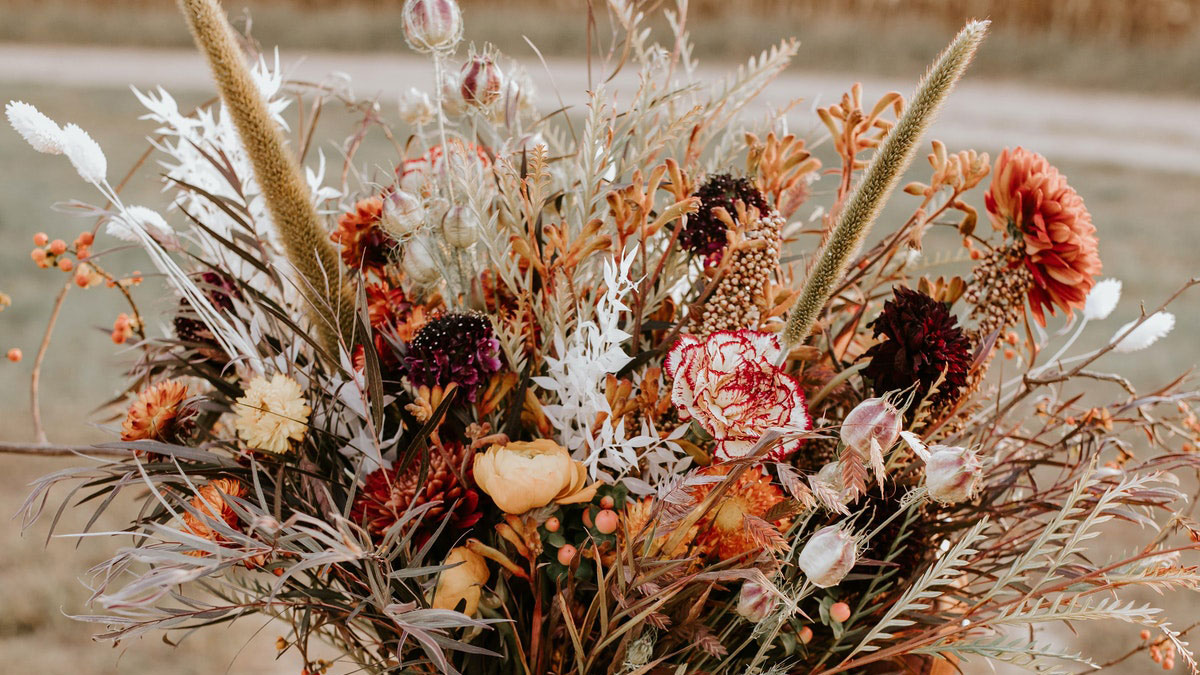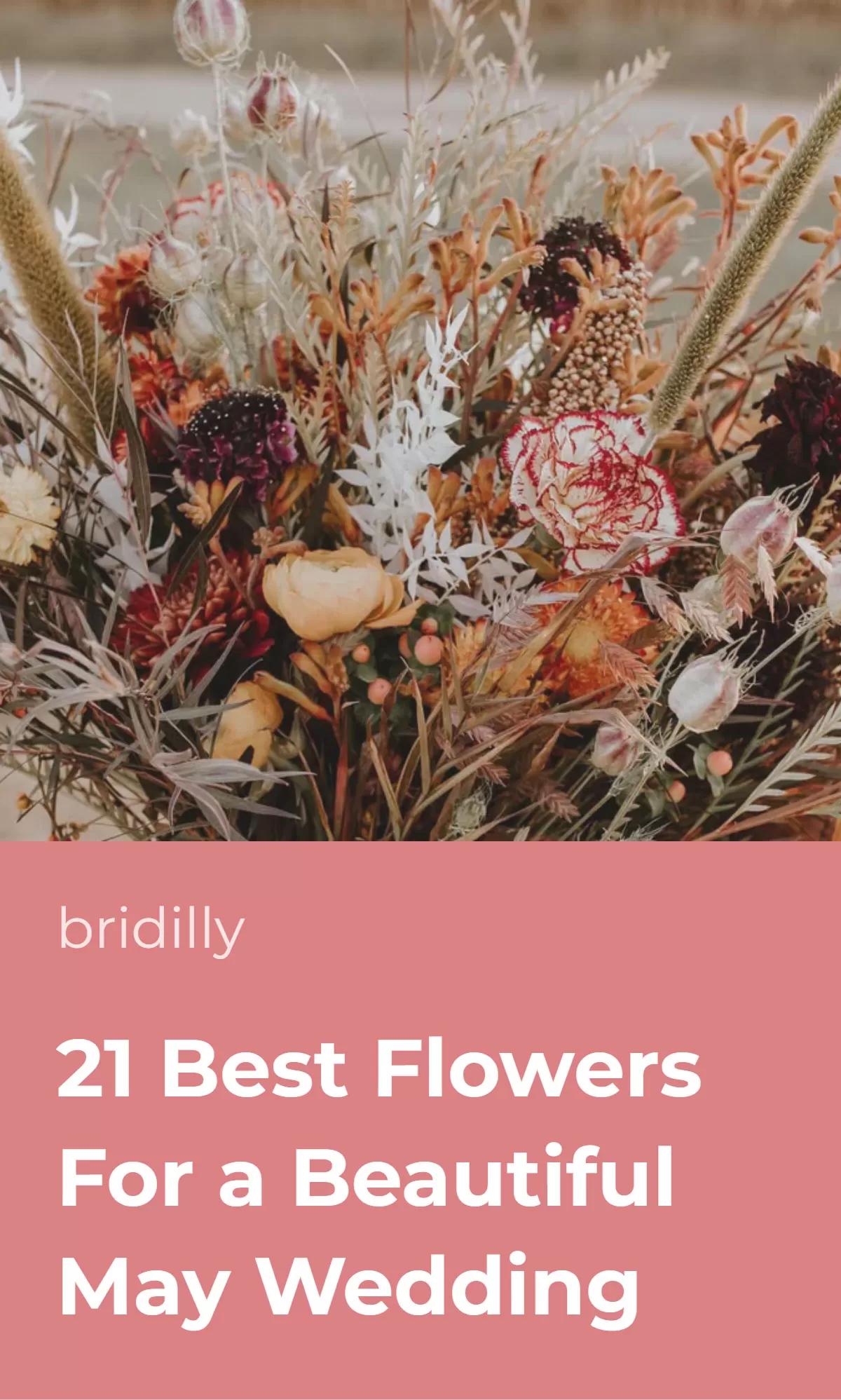Late spring couples are blessed with many stunning seasonal May wedding flowers to choose from.
While winter couples often have a limited flower selection, spring boasts so many beautiful varieties that narrowing down the options becomes a tricky task.
Of course, many popular wedding flowers nowadays are available year-round, like roses or tulips.
However, some of the most delicate, dreamy cultivars only bloom in spring – lilac, wisteria, and lily of the valley, to name a few.
Flowers are an integral element of your wedding atmosphere, so choosing the right varieties is vital. When researching your options, consider your wedding style, location, and color code.
Table of Contents [show]
1. Snapdragon
Snapdragon is a long-stemmed flower with unusually shaped clustered blooms that come in many colors, including two-toned varieties.
Snapdragons are ideal for modern asymmetric bridal bouquets and venue décor. Mix them with dahlias, carnations, anemones, lilac, wisteria, or other seasonal spring flowers.
Snapdragons also make creative boutonnieres. They have a long vase life and will look fresh throughout your entire wedding day.
2. Anemone
Anemones are available year-round, but spring is their prime time. May is when anemones are the freshest, and the color selection is the widest.
You can choose among fiery red, pink, burgundy, purple, blue, plum, and white hues. The white variety carries a fun name, panda, and the red one resembles poppies.
Anemones look gorgeous in elaborate arrangements with other spring garden blooms, such as peonies, roses, and gardenias.
3. Anthurium
Anthurium is an elegant exotic flower with a single waxy petal. It comes in various shades, including red, pink, white, orange, and unusual purple, blue, green, and black.
Anthurium looks the best in modern oversized, asymmetric, or cascading bouquets with other exotic blooms and greens, like fern leaves, calla lilies, orchids, and pampas grass.
However, it also pairs well with some garden flowers, including roses, peonies, freesias, hyacinths, and snapdragons. Single anthurium blooms make stylish boutonnieres, hairpieces, and table décor.
4. Carnation
Carnations have numerous benefits: they are cost-effective, long-lasting, versatile, and simply beautiful. Carnations make any bouquet appear more creative due to their ruffled texture and unique color combinations.
Combine carnations with peonies, roses, ranunculus, and sweet peas for an endlessly romantic arrangement, or mix them with daisies, cornflowers, Craspedia, and starflower for a rustic appeal.
A mono carnation bridal bouquet is a chic choice if you prefer minimalism. Consider two-toned decorative varieties for a more interesting look.
5. Lilac
Lilac is typically purple, but some cultivars are white, pink, or magenta. These small, pretty blooms are perfect for your spring wedding floral arrangements, giving them a whimsical, dreamy feel.
Lilac is a versatile flower suitable for bouquets, aisle and ceremony arch decoration, centerpieces, boutonnieres, and flower crowns.
The combinations with lilac are endless – you can pair it with garden blooms like roses and peonies, wildflowers like cornflowers and lily of the valley, or opt for a minimalistic yet romantic mono lilac bridal bouquet.
6. Sweet Peas
These delicate spring flowers with a sweet fragrance come in various colors, from white and sky blue to bright azure and magenta. A mono sweet pea bridal bouquet is a dainty, modest choice.
Alternatively, you may mix sweet peas with hyacinths, hydrangea, lilac, freesia, and other subtle spring blooms.
One point to note is the relatively short lifespan of sweet peas. They will stay long in water as centerpieces, but if you choose a sweet pea bridal bouquet, ensure it’s as fresh as possible.
7. Lily of the Valley
The small white or blush lily of the valley blooms serve as perfect bouquet fillers, pairing well with tulips, freesias, orchids, gardenias – the list goes on.
However, a mono lily of the valley bridal bouquet is an impeccably chic choice for minimalism lovers. Such floral arrangements also make beautiful centerpieces or boutonnieres.
8. Tulip
While tulips are popular wedding flowers available year-round, most varieties are spring bloomers. There are dozens of cultivars, including fringed parrot tulips, two-toned greigii tulips, and tall French tulips.
You may mix and match different tulip colors or combine them with other spring flowers – tulips are truly versatile and go well with garden, rustic, and exotic blooms.
Furthermore, tulips will remain fresh for a long time and continue to open if put in a vase.
9. Orchid
Orchids are popular exotic wedding flowers suitable for various styles and applications. They look equally gorgeous in modern asymmetric or cascading bridal bouquets and simple arrangements.
Single orchid blooms are ideal for boutonnieres and hairpieces, while long orchid stems look stylish in tall vases as centerpieces.
10. Peony
Large, textured peony blooms look endlessly romantic and can add volume to any bouquet. While peonies come with a hefty price tag, it’s justified by a long vase life and versatility.
Peonies come in many colors, including unusual two-color combos, and thus fit any wedding style and color theme.
Florists typically use peonies for bouquets and venue décor, as they are too large for boutonnieres, hairpieces, and cake toppers.
11. Rose
If there was a flower hierarchy, roses would undoubtedly be on the top. Roses have a long cultivation history and boast dozens of species, including wild, miniature, and climbing roses.
Due to the wide variety selection, roses fit any wedding style and location. Furthermore, they are cost-effective and long-lasting. You simply can’t go wrong with this popular flower.
12. Gardenia
Gardenia trees have large evergreen leaves, waxy white petals, and an intoxicating fragrance. Fun fact – gardenia belongs to the coffee family, although it won’t help you wake up in the morning.
These elegant blooms are highly versatile. You may opt for a classic gardenia bridal bouquet, wear a couple of flowers in your hair, incorporate gardenia in your centerpieces, or decorate the venue with gardenia wreaths.
Even if gardenia isn’t on your favorites list, consider adding its leaves in your wedding floral arrangements to make them more creative.
13. Amaryllis
Amaryllis is an exotic late spring flower with multiple bell-shaped blooms on a single stem. It comes in a plethora of colors, including contrasting two-tone combinations.
Amaryllis works well in bouquets, centerpieces, boutonnieres, and other applications. Mix it with other exotic flowers like lilies and anthuriums or garden blooms like tulips and freesias.
14. Freesia
Freesia flowers can be single or double and come in many pretty shades, from white and cream to deep red and purple. A single stem may feature up to eight trumpet-shaped blooms.
Freesia wedding arrangement ideas are endless – they look great with roses, carnations, chrysanthemums, hyacinths, and many more spring flowers.
15. Muscari
Muscari hyacinths typically range from blue to purple, but you can also come across white, pink, and peach varieties. These unusual flowers with clustered grape-like blooms are a stylish choice for a spring bridal bouquet.
Hyacinths can be used in bouquets, venue décor, and small accessories like boutonnieres. Mix them with other seasonal blooms like lily of the valley, irises, daffodils, and tulips.
16. Poppy
Poppies bloom from April to June, so May is the best time for a poppy bridal bouquet. They boast vivid red, purple, pink, coral, and peach shades and perfectly fit rustic, whimsical, and bohemian weddings.
True to their name, poppies add a vibrant pop of color to any floral arrangement and go well with a range of garden and wildflowers, including sunflowers, cornflowers, peonies, roses, and anemones.
17. Wisteria
Dreamy hanging wisteria comes in white, purple, and pink shades. This romantic flower is most often used for venue decoration, for instance, adorning ceremony arches or chandeliers.
Wisteria is also suitable for trendy cascading bridal bouquets with garden blooms, for instance, lilac, hyacinths, or peonies.
18. Foxglove
Foxgloves look similar to snapdragons but have differently shaped blooms and an even wider color selection, including blue and multi-colored varieties.
Foxgloves are an excellent addition to any spring wedding bouquet, giving a modern twist to otherwise ordinary arrangements. They look incredibly stylish with hyacinths, delphinium, lilies, peonies, and greens.
19. Daffodil
Daffodils are truly iconic spring flowers, and while the most common color is undoubtedly yellow, they also come in white, pink, and orange.
Choosing a daffodil bridal bouquet or venue décor is an excellent way to incorporate sunny pops of color in your celebration. Combine daffodils with other signature spring blooms, such as hyacinths, lily of the valley, and lilac.
20. Viburnum
Viburnum is a gorgeous flowering shrub resembling hydrangea, with small, clustered white, cream, greenish, yellow, red, blue, or burgundy blooms.
Viburnum can add volume and texture to your bridal bouquet or centerpieces, giving them an aerial, dreamy feel. Mix viburnum with hydrangea, peonies, roses, snapdragons, and other garden flowers.
21. Craspedia
Are you looking for a creative twist for your floral wedding arrangements? Consider Craspedia – these dense, globe-shaped blooms, also known as Billy Balls, can make even the simplest bouquet appear unusual.
In nature, Craspedia flowers are always vivid yellow, but florists can dye it any color you wish to match your wedding color theme.
For instance, natural yellow Craspedia will look stunning in a rustic daisy and sunflower arrangement, whereas a sky blue Craspedia will suit a romantic blue hydrangea bouquet.
If you have a wedding in preppy style, you may even choose a mono colorful Craspedia bouquet and boutonnieres for a playful look.















No Comments Add one
Leave a Comment